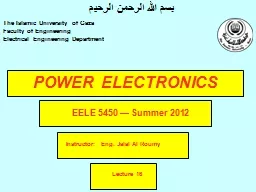

Instructor Eng Jalal Al Roumy The Islamic University of Gaza Faculty of Engineering Electrical Engineering Department بسم الله الرحمن الرحيم ID: 243545
Download Presentation The PPT/PDF document "POWER ELECTRONICS" is the property of its rightful owner. Permission is granted to download and print the materials on this web site for personal, non-commercial use only, and to display it on your personal computer provided you do not modify the materials and that you retain all copyright notices contained in the materials. By downloading content from our website, you accept the terms of this agreement.
Slide1
POWER ELECTRONICS
Instructor: Eng. Jalal Al Roumy
The Islamic University of Gaza
Faculty of Engineering
Electrical Engineering Department
بسم الله الرحمن الرحيم
EELE 5450
—
Summer 2012
Lecture
16Slide2
Chapter six
A Free-Wheeling Diode DC Motor Drive Using the Jones Chopper
This circuit is frequently referred to as a chopper circuit.Slide3
Chapter six
Operation of the Jones Commutation circuit
The Jones circuit is an efficient commutating method to turn off
the main
SCR in the dc chopper circuit.
The circuit characterized by class D commutation (charged capacitor switched by SCR2 and T1) (Ton
and Toff can be varied)Slide4
Chapter six
Operation of the Jones Commutation circuit
Initially SCR1 and SCR2 are not conducting and the side B of the capacitor C is charged to a negative voltage (from last SCR2”on”).Slide5
Commutating current through SCR1,L2, D2 and C charges up the capacitor to opposite polarity, B is positive
At time t1 SCR1 is triggered ,and the current passed through the load.Slide6
The capacitor retains its charge until SCR2 is triggered at t3Slide7
The discharged of capacitor C reverse biased SCR1 and turn it off.Slide8
C again charges up with A positive(energy in L1) and SCR2 turns off because its current falls below the holding value when C is recharged.Slide9
The autotransformer action of T1 induced voltage in L2 of correct polarity for charging the commutating capacitor to a voltage > VBSlide10
The bottom plate (B) of capacitor C reaches a peak value at t5.Slide11
Since
Vc (at t5) is charged to a voltage greater than VB, D2 is again forward biased. C discharges to a value lower than VB .Slide12
The blocking voltages across SCR1 and SCR2 also changes (t5 to t6).
The turn off time of SCR2 must be less than the time from t5 to t6.Slide13
The discharging of C stop at t7 when current through L2 falls to zero.Slide14
The cycle repeats itself when SCR1 is again triggered.Slide15
Chapter six
Design of the Jones commutation circuit
The basic design of the commutating circuit involves the proper choice of ‘C’ and autotransformer T1Slide16
Chapter six
Design of the Jones commutation circuit
The magnitude of the commutating capacitor is dependent on the following circuit parameters:
Maximum motor current to be commutated,
Im
.Turn-off time,t0, of SCR1.The battery voltage, VB. End of
Lecture